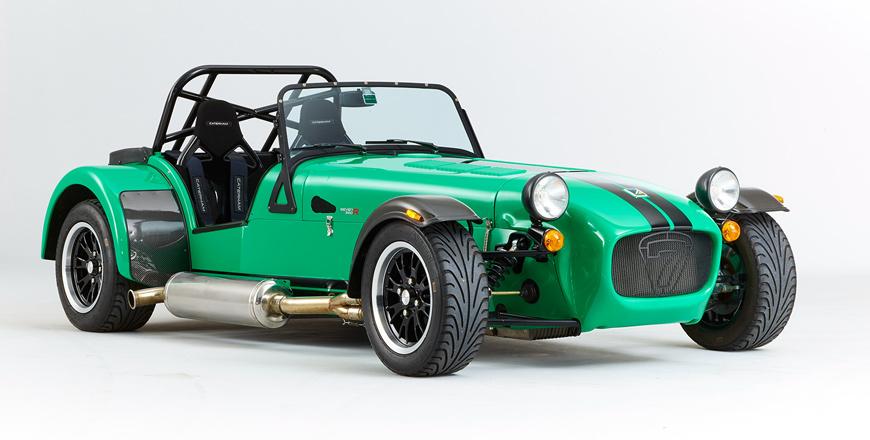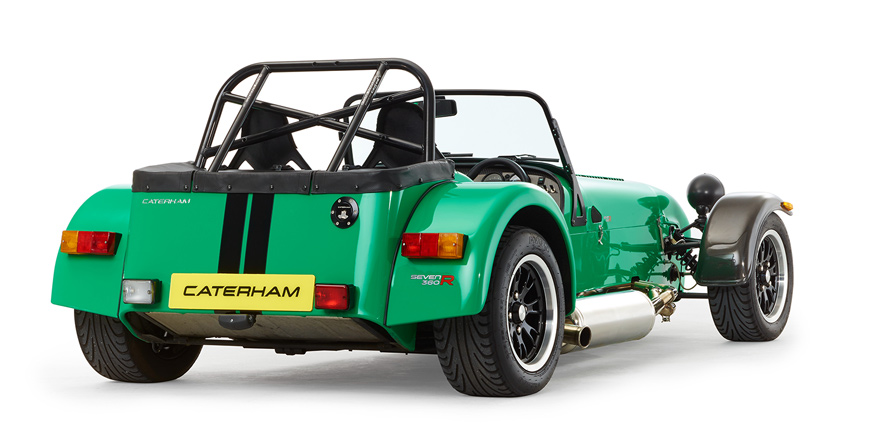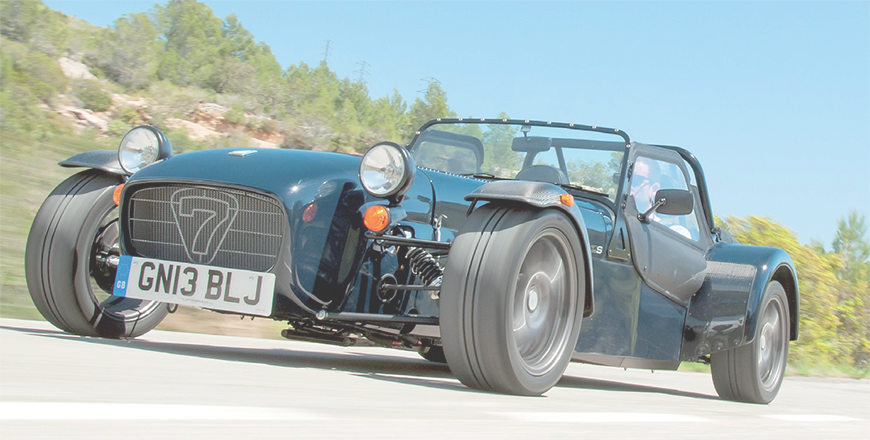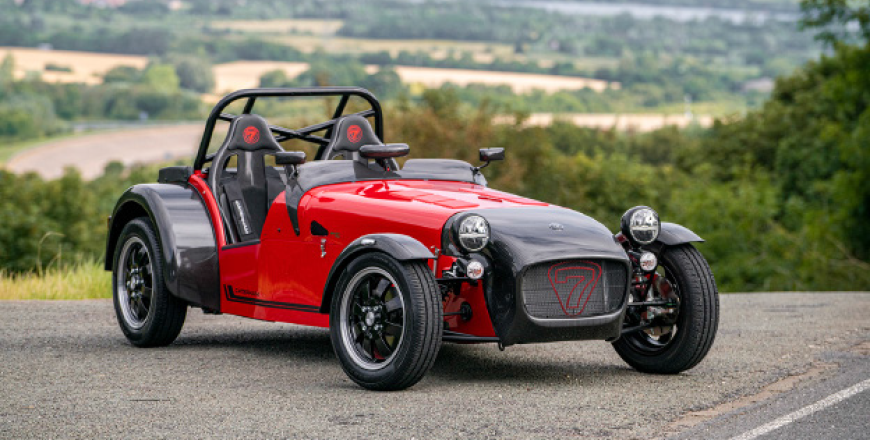You are here
Caterham Seven 360S SV: Distilled and direct
By Ghaith Madadha - May 10,2021 - Last updated at May 10,2021

Much evolved and honed since Caterham took over production in 1973, the Seven has come a long way, but retains a clear connection and lineage to the original 1957 Lotus Seven.
Offered in a broad range of power outputs, states of tune and standard or wide chassis SV guise, the 360 is the entry point to the larger 2-litre engine variants of the current Seven. Available in track biased R version or road-oriented S guise, the UK market 360 (as pictured) is also known as the 355 in left-hand-drive export guise.
Back to basics
A pared down and unreconstructed machine, the Seven aims at delivering a connected driving experience and little rivalled agility and handling abilities. In that pursuit, it follows a decidedly simple but highly effective minimalist philosophy of weight reduction that omits even the most basic conveniences, including steering assistance, much less doors and electronic driver assistance systems, with the greater weight reduction making possible further reductions and lighter and lesser components. The result is a phenomenally focused car that rewards drivers with its detailed nuance, feedback and go-cart like responsiveness.
Little changed in spirit or its iconic style over the years, the Seven’s recipe is one where form follows function. Light, low and small, with engine mounted far back in the front and wheels pushed far out for ideal within-wheelbase weight distribution, low centre of gravity and a big footprint, the Seven is built on a rigid tubular frame and features an occasional use soft top and light aluminium panels. It also features partially exposed front suspension and external side-mounted exhaust tubing, and rollover bar, with driver-machine connectivity being its primary safety system.

Howling and high-revving
Weighing just 585kg in SV guise, the Seven 360S makes the most of it high-revving naturally-aspirated 2-litre engine’s 180BHP output, rocketing through 0-97km/h in mere 4.8-seconds and onto 209km/h. Throaty and guttural, the 360S’ Ford Duratec engine’s visceral medley of rasps, gurgles, barks, howls and spitting pops are amplified by its exposed side-mounted exhaust and open top. Developing maximum power at 7,300rpm and 143lb/ft torque at 6,100rpm, the 360S is aggressively high revving, but being so light, torque still feels brutally and responsively versatile from low revs and through mid-range.
With 5-speed gearbox optimised between close ratio performance and relaxed daily driving, the 360S is muscular in mid-range and viscously long-legged when taken to its rev limit, while lightweight allows long, relentlessly sweeping acceleration before the next gear. Through corners, the 360S delivers precise throttle control for adjusting how much power to dial in. Elemental and engaging, the 360S’ acoustics brilliantly complement its easy revving and urgent delivery, and its stiff yet slick, succinct and mechanical feeling short throw gear shifts, delicately precise and intuitive clutch biting point, and accurate braking pedal feel.
Undiluted dynamics
A distilled driving experience, the 360S might not be the most extreme Caterham available, but is nevertheless a more focused and direct car than most else. With its exposed nature, the Seven is an intoxicating drive, with unassisted brakes and steering adding to its direct dynamics and connected feedback. Scalpel sharp through corners, its steering offers textured and nuanced feedback and pinpoint accuracy, while quick 1.93-turns lock-to-lock, allows one to keep hands at quarter-to-three position, through most corners. Eager and undiluted, turn-in is sharp and responsive, while body control is sublime through successive corners.
With razor sharp responsiveness, flat cornering, lightweight and exacting throttle control, the 360S is a corner-carving hero that rewards precise driving with grace and thrilling point-to-point speed. Smoothly reapplying throttle by mid-corner, the Seven digs taut into tarmac and blasts off onto a straight, but with no electronic safety nets, it should be treated with respect. More refined and capable than early Sevens, the 360S features a sophisticated De-Dion rear axle and independent front suspension, and delivers nuanced and textured road feel, and surprisingly high grip limits.

Sure-footed and focused
With masterful suspension set-up, the Seven SV is sure-footed, buttoned down in vertical movement and track-ready, but in road-biased S guise is supple and fluent riding over road imperfections. With its light weight, low driving position and open top enhancing the sensation of speed, the Seven is sensational through switchbacks, but still feels stable at speed despite aerodynamic lift generated by its upright design. Meanwhile, owners can opt for a personalised suspension and steering geometry set-up to more precisely distribute weight for further — driver-specific — handling, comfort, steering and braking enhancements.
An exhilarating experience that focuses ones driving and places responsibility for every input with the driver, the Seven’s grip levels are reassuringly high, but allows one to exactingly dial in sideways slip if demanded.
Supportive and snug yet not uncomfortable, lowering into the Seven’s cabin is easier than appears, where one sits legs extended deep into its long footwell and hands falling perfectly on its small steering wheel within easy reach of its stubby gear lever and basic controls. Mounted on detachable reenforced leatherette doors, side mirrors can, however, be shaky at speed.
TECHNICAL SPECIFICATIONS
Engine: 2-litre, front-mid, in-line 4-cylinders
Valve-train: 16-valve, DOHC
Bore x stroke: 87.5 x 83.1mm
Compression ratio: 10.8:1
Gearbox: 5-speed manual, rear-wheel-drive
Power, BHP (PS) [kW]: 180 (182) [134] @7,300rpm
Specific power: 90BHP/litre
Power-to-weight: 307.7BHP/tonne
Torque, lb/ft (Nm): 143 (194) @6,100rpm
Specific torque: approximately 97Nm/litre
Torque-to-weight: 331.6Nm/tonne
Redline: 7,600rpm
0-97km/h: 4.8-seconds
Maximum speed: 209km/h
Fuel capacity: 41-litres
Length: 3350mm
Width: 1685mm
Height: 1115mm
Wheelbase: 2305mm
Weight: 585kg
Steering: Rack & pinion
Lock-to-lock: 1.93 turns
Suspension F/R: Double wishbones/De Dion axle
Chassis: Tubular space-frame
Brakes: Discs
Tyres: 195/45R15
Related Articles
First introduced in 1957 under the Lotus badge and in continual development since Caterham took over production in 1973, the Seven is — at f
Undiluted, uncomplicated and unburdened by excess or frivolity, the ultra-lightweight Caterham Seven 485S is a distilled driving machi
As the trend for more complicated and ever heavier electric and hybrid cars and high-riding crossovers and SUVs grows, small, lithe and ligh



















